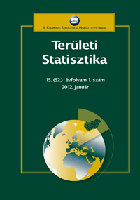Vidéki nagyvárosaink gazdaságának összehasonlító elemzése
A Comparative Analysis of the Hungarian Minor Cities
Author(s): Ernő Molnár, Gyula Dézsi, István Máté Lengyel, Gábor KozmaSubject(s): Social Sciences, Economy, Geography, Regional studies
Published by: Központi Statisztikai Hivatal
Keywords: minor cities; economic dynamics and structure; growth pole; dual economy
Summary/Abstract: The research of minor cities – also due to the development policy context of the topic – draws significant attention to the contemporary Europe. Examination of the economic dynamics and structure of minor cities regarded as potential growth poles is particularly important in the monocentric space structure of Hungary determined by the dichotomy of Budapest and the rural regions. Our study, after an overview of the relevant Hungarian literature, analyses the estimate deconomic strength (gross domestic product)of settlements and some locally aggregated economic performance indices of companies using the double-entry book keeping system. It also examines the economic development tendencies and the changing relative position of the Hungarian minor cities after the turn of the Millennium,based on data of large, medium-sized and potential medium-sized enterprises registered in these cities. A major result of the paper is that the integration into the global production networksl ed by big foreign companies as well as there-industrialization process can be primarily observed in the background of the economic success,which is also associated with some potential threats (like one-sided dependency or limits oflocal value added). The economic duality of Hungary is well reflected in the performance differences of minor cities, showing the advantageous position of centres located closer to the capital, benefiting from both localization economies and borrowed size.
Journal: Területi Statisztika
- Issue Year: 58/2018
- Issue No: 06
- Page Range: 610-637
- Page Count: 28
- Language: Hungarian

